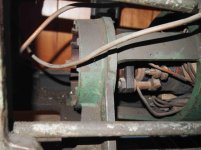Walt Dizzy
Plastic
- Joined
- May 31, 2013
- Location
- McFarland WI
I purchased this motor-generator 10EE several months ago. Money was tight until recently. Now I have a 220 v 40A line feeding a 7.5 hp rotary phase converter in my shop.


The lathe came with this box in the back. I think it was a DC converter box for running the DC motor. I damaged it in moving the lathe into my house and have discarded it. Not sure it was functional before I mangled it.

My goal is to use the Monarch motor-generator unit. The original wiring has been altered to accept the after market DC converter, and I need to restore the wiring back to original.
Here's a picture of the motor starter. (Sorry for the odd angle, I had to dismount it to get a decent picture due to limited space at the back of the lathe.)

It looks similar, but not the same as the Allen-Bradly unit in this thread:
10EE starting circuit with Allen-Bradley contactor
I will be ordering the manuals from Monarch for my lathe. Hopefully there will be electrical diagrams included.
A question for the forum members, is this starter suitable for my lathe? If so, is it feasible to determine how it should be wired correctly?
Walt


The lathe came with this box in the back. I think it was a DC converter box for running the DC motor. I damaged it in moving the lathe into my house and have discarded it. Not sure it was functional before I mangled it.

My goal is to use the Monarch motor-generator unit. The original wiring has been altered to accept the after market DC converter, and I need to restore the wiring back to original.
Here's a picture of the motor starter. (Sorry for the odd angle, I had to dismount it to get a decent picture due to limited space at the back of the lathe.)

It looks similar, but not the same as the Allen-Bradly unit in this thread:
10EE starting circuit with Allen-Bradley contactor
I will be ordering the manuals from Monarch for my lathe. Hopefully there will be electrical diagrams included.
A question for the forum members, is this starter suitable for my lathe? If so, is it feasible to determine how it should be wired correctly?
Walt









